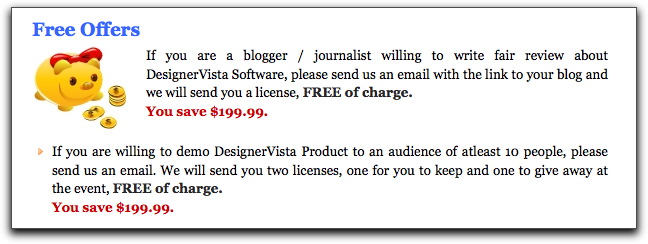What’s the one thing your startup needs more than great code, a killer marketing message or a compelling offer? Attention. Without attention, no one will know your startup has created the must-have web, desktop or mobile app of 2009, or that you even exist.
So how do you get attention? In this post I’d like to suggest 3 ways to get attention when you don’t have the kind of money it takes to hire a great PR firm with connections that will do more than spam every online writer with a heartbeat and an email address.
Be an expert – and share that expertise.
Two recent examples of this. First there’s Amy Hoy, who with her husband Thomas (script.aculo.us) Fuchs and two partners recently launched freckle time tracking. In early January as step one of her getting attention of her target market segment – developers and web designers – campaign Amy released a free ebook on credit card processing. Now this is one of those boring, utterly necessary subjects that a free ebook with great presentation + good graphics + humor + sourcecode is irresistible linkbait. And just to add value, Amy’s now working on version 2: a great reason to share your email even if your inbox is already stuffed.
Now maybe your graphic skills aren’t up there with Amy and more like mine (I failed crayons in kindergarden and they’ve gone down from there). Never fear – there are other ways of turning the same deep domain knowledge you’ve developed into ways of getting your software business attention.
Part of that knowledge is already having done the work to find other sites that have valuable information about a subject. If you save someone time by maintaining and recommending a quality list of annotated sites your customers are interested in, that’s value for your customers and traffic to your site.
Next, there’s Gurock Software and Dennis Gurock who makes a great programming tool, SmartInspect. How do compete for attention against all those other tools by vendors much larger than you? You build microsites. Dennis created two sites with their own SEO-friendly URLS on .NET and Java logging (no, not cutting down trees, but cutting down defects automatically logging events with an application while in development mode). Each site is nothing more – and nothing less – than a great introduction to logging tracing, an annotated list of proprietary and Open Source tools and libraries, recommended articles and links and key concepts.
Make influencers a great offer.
One of the most effective ways you can get attention for your product or web app is to get bloggers talking about it. One way is to create and maintain a blog your customers find interesting and engaging. But frankly, not everybody wants to be a blogger. Here’s another approach: give them your software.
Take for example another developer tool DesignerVista. Kumaravel Somasundaram has a standing offer to bloggers, journalists and others right on his buy page that makes perfect sense:
I especially like Kumaravel’s understanding that there are not just bloggers and journos influence people with his offer to anyone willing to demo DesignerVista to ten other people: a perfect enterprise brown-bag lunch gathering in the making.
Build it in.
I recently interviewed Tony Wright, CEO and founder of Rescuetime.com, a time tracking and management startup for the Apress book I’m writing, The Startup Success Guide. I found what Tony told me to be fascinating.
From the very beginning Tony knew that he would be competing for attention in a very crowded market. There are currently something north of 300 time management/Getting Things Done applications being sold. What’s more, he understood that it would be easy – and possibly fatal – to fall into the trap of being YAGTDA (yet another Getting Things Done application).
Tony’s solution: make what RescueTime documented for each user and anonymously for users in aggregate jaw-dropping, double-taking surprising real news:
Drawing on anonymous data from its userbase, Rescuetime could report:
- The average IM user shifts to an IM window *77* times per day (avg of 11.5 times per hour or once every 5.2 minutes).
- Average number of unique web sites visited per day is 40 (that’s domains, not pages).
- Average number of unique applications touched is 17.
- 26% of time was spent inside a browser.
- 61% of time was spent on internet dependent stuff (web sites plus applications who pull/push data from the internet)… So unplugging is not a very practical option.
Interesting, right? The New York Times thought so. So did the BBC. BusinessWeek, PCWorld and a slew of other media outlets whose job is telling their readers who to pay attention to.
From before RescueTime launched up to now 16 months later, RescueTime has made real live news generation the cornerstone of it’s marketing strategy.
Has it paid off? Well, Tony and his two partners started RescueTime with their own money, then soon got the attention of startup-funding Y Combinator that put in the first $20K of funding. RescueTime closed their Series A round of funding for $900k in September 2008.
The bottom line for a software company, especially a startup, is that finding a way to legitimately gain attention is critical, core, job you need to do to succeed. There’s no one solution, no one path, but with a little creativity and work, you can get the attention your company needs.
This post was written for Avangate by special arrangement. But I’d say the same thing anywhere anyway.







